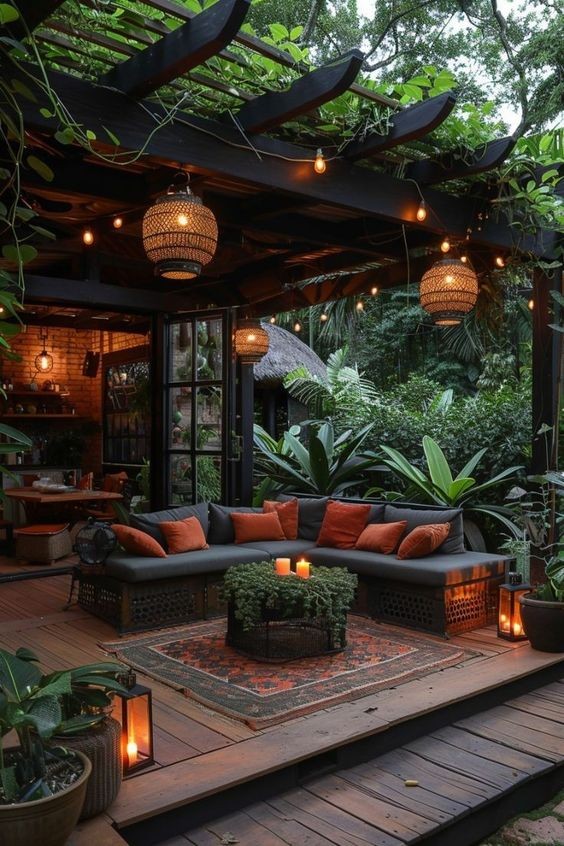Creating the Perfect Backyard Sitting Area: A Comprehensive Guide
Introduction
A well-designed backyard sitting area can transform your outdoor space into a relaxing retreat where you can unwind, entertain guests, and enjoy the beauty of nature. Whether you have a sprawling garden or a cozy patio, the key to creating a successful sitting area lies in thoughtful planning and consideration of various elements. This article explores the essential aspects of designing and decorating a backyard sitting area, from choosing the right location to selecting furnishings and accessories.
1. Assessing Your Space
1.1. Size and Layout
Before diving into design choices, evaluate the size and layout of your backyard. Measure the area you have available for your sitting area, taking note of any existing features such as trees, paths, or structures. This will help you determine the best location and scale for your furniture and decorations.
1.2. Sunlight and Shade
Consider how sunlight and shade move across your backyard throughout the day. This will influence where you place your sitting area. Ideally, you want a balance of sun and shade to ensure comfort at different times of the day.
1.3. Privacy
Think about the level of privacy you desire. If your backyard is overlooked by neighbors or faces a busy street, you might want to incorporate elements like screens, trellises, or plants to create a more secluded and intimate space.
2. Choosing the Right Furniture
2.1. Types of Furniture
The choice of furniture largely depends on how you plan to use your sitting area. Here are some popular options:
Sofas and Chairs: Comfortable, weather-resistant sofas and chairs are ideal for relaxing and entertaining. Look for materials like teak, eucalyptus, or synthetic wicker that can withstand outdoor conditions.
Dining Sets: If you enjoy outdoor meals, a dining table with chairs is a must. Opt for materials that can handle rain and sun, such as metal or treated wood.
Lounge Chairs and Recliners: For a more laid-back atmosphere, consider lounge chairs or recliners. They are perfect for sunbathing or reading a book.
2.2. Material Considerations
Outdoor furniture should be durable and easy to maintain. Common materials include:
Wood: Offers a natural look but requires regular maintenance to prevent weather damage.
Metal: Includes aluminum and wrought iron. Metals are sturdy but can get hot in direct sunlight.
Synthetic Wicker: Lightweight and resistant to weather, making it a popular choice for many outdoor settings.
Fabric: Choose outdoor fabrics that are water-resistant and UV-protected to ensure longevity.
2.3. Comfort and Style
Comfort is key for any sitting area. Use cushions and throws to enhance comfort and add a touch of style. Make sure to select fabrics that are specifically designed for outdoor use to prevent mildew and fading.
3. Incorporating Accessories
3.1. Lighting
Proper lighting can extend the usability of your sitting area into the evening and create a cozy ambiance. Consider these options:
String Lights: Add a whimsical touch with string lights draped across trees or pergolas.
Lanterns and Candles: Provide soft, warm light and a romantic atmosphere.
LED Fixtures: Energy-efficient and long-lasting, LED lights can be integrated into paths, walls, or overhead structures.
3.2. Rugs and Carpets
Outdoor rugs can define your sitting area and add comfort underfoot. Choose materials like polypropylene or nylon that can handle exposure to the elements.
3.3. Planters and Greenery
Incorporate planters and greenery to enhance the natural feel of your space. Use a mix of flowering plants, shrubs, and even small trees to create a lush and inviting environment. Vertical gardens or hanging planters can also save space and add visual interest.
3.4. Fire Pits and Heaters
To make your sitting area usable year-round, consider adding a fire pit or outdoor heater. Fire pits provide warmth and a focal point for gatherings, while heaters can extend the outdoor season into cooler months.
4. Designing for Functionality
4.1. Layout and Flow
Arrange furniture to create distinct zones within your sitting area. For example, a conversation area with a sofa and chairs, a dining zone with a table and chairs, and a lounging area with sunbeds. Ensure there is ample space for movement and accessibility.
4.2. Weather Considerations
Plan for various weather conditions by choosing weather-resistant furniture and coverings. A retractable awning or a pergola can provide shade and shelter from rain, making your sitting area more versatile.
4.3. Maintenance
Regular maintenance is essential to keep your sitting area looking its best. Clean furniture and accessories regularly, and perform any necessary repairs or treatments to prolong their lifespan.
5. Personalizing Your Space
5.1. Color Scheme
Choose a color scheme that complements your home’s exterior and reflects your personal style. Soft neutrals create a calming atmosphere, while bold colors can make a statement.
5.2. Artistic Touches
Incorporate personal touches such as artwork, sculptures, or decorative items that resonate with you. These elements can make the space feel uniquely yours.
5.3. Functional Additions
Consider adding functional elements like side tables, storage benches, or a small outdoor kitchen to enhance convenience and usability.
Conclusion
Designing a backyard sitting area is an exciting opportunity to create a space that enhances your outdoor living experience. By carefully considering the size and layout of your area, choosing the right furniture and accessories, and incorporating personal touches, you can build a retreat that reflects your style and meets your needs. Whether you’re hosting a summer barbecue or enjoying a quiet evening under the stars, a thoughtfully designed sitting area can become one of the most cherished spaces in your home.






